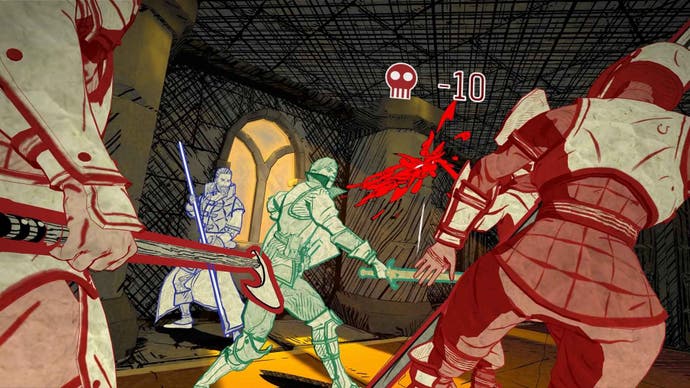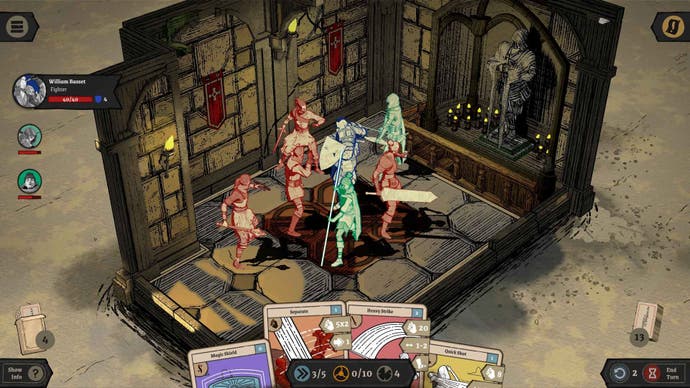Knights in Tight Spaces brings fantasy RPG trappings to a Roguelike core, and they make a significant difference
It's party time.
I liked Fights in Tight Spaces. It mashed together two things I'm fond of: Roguelike deck-builders and badass secret agents. FITS gave me a turn-based experience that made me feel like Jason Bourne, punching and kicking and weaving my way around enemies on cramped battlefields. I stepped around their punches and redirected them back at them. I slammed their heads into walls and tables. I dodged bullets - whoa. I even booted people off the wings of aeroplanes. I survived insurmountable odds. FITS did what it promised and fulfilled my hand-to-hand spy-fight fantasy. But where does the series go from here? Well, the answer is hundreds of years back in time, to medieval times, to Knights in Tight Spaces.
KITS swaps suits for suits of armour, guns for bows and arrows, and stark primary colours for a more wood-carved, tavern-table look. Underneath, though, the core is more or less the same. It's still turn-based, still grid-based, and you're still fighting in tight spaces and building a deck with card-based abilities. And it's not just a reskin. KITS has changed the formula in ways that make a surprising difference.
The biggest difference is the game no longer revolves around one character - you are no longer the lone spy infiltrating an enemy base. Instead, and as in the grand tradition of fantasy role-playing games, you now do it with a party, which makes for a fundamental shift in gameplay. There are a few elements to this.
The first is you now choose from a variety of characters to play as. In FITS, you were the default spy always, but here you can be a rogue or a mage or a fighter, etc. - it's a familiar fantasy spread. Who you are changes what you do in combat. I play as a brawler who punches and kicks and behaves a lot like the spy from the first game. But the archer who joins my team later plays differently. They do their best work at range, so working with them involves keeping distance on the battlefield. It's a nice way to give clusters of new considerations to think about.
When an ally joins you, they bring their own set of moves with them - read: set of cards - which automatically mix in with those you already have. And yes, if your deck-building instincts are tingling and this makes you nervous, you're having the correct reaction: it's hard to maintain a trim deck here. Allies bulk decks out. Furthermore, what an archer can do will obviously differ from what a brawler can do. There's some crossover - archers can use some melee attacks - but many cards will be usable by only one or the other. It's possible to be served a hand that doesn't really work for the character you want to use. Mix a third character into that and the likelihood of a useless hand increases.




Building this complexity further is the rule that all characters share the same energy pool. You won't be able to individually go through each of them and move and fight. You'll need to prioritise, usually depending on who's in the most immediate danger. What it means is your considerations have multiplied by the number of characters you have on the board. Are they all safe from being hit at the end of the round? Who's in the best position to do the most damage? Do you have the right cards available to do what you want to do? The focus becomes a group one. And the key to mastering it is, of course, synergy.
At the heart of it all is the game's new ally attack. If an ally is within range of an enemy that another ally is attacking, they will automatically attack as well. In other words, they get a free hit, which is an incredibly powerful thing to have in a game like this, where every advantage counts. If you can manipulate the battlefield so that every time one of your characters strikes, their allies do too, then you're doubling or tripling your damage. Therefore, it's a prime consideration. It also taps into what makes this series so satisfying to play in the first place: tactical smugness. It's the feeling you get when you manage to thread the needle and string together a devastating series of attacks. It's looking at a seemingly impossible situation and seeing the move that makes it possible. It's a bit like nailing that killer move in a chess game that all the audience gasps at. It feels like that.
Outside of combat, the fantasy RPG focus has a sizable impact too. There's a new dialogue system in the game, whereby you can talk to allies on a kind of unfurling scroll, which brings a sense of character to the game. It's also here you'll negotiate over quests and rewards, and recruit allies, giving you further agency over what's going on. There's a new side-quest function, which allows you to break away from the restricted, either-or progression of the main Roguelike map and take on missions separate from it. I like this because it means you never miss out on potentially juicy loot from elsewhere. Speaking of which: you can now equip characters. There are swords and shields and armour and things like that, and are also items that enable magical abilities, which can be game-changing. Again, it's more to think about - many more pleasing mini-puzzles to serve the larger whole.
Taken altogether, it makes for a significantly different experience to the first game, and a more personable one. But what worries me slightly is bloat. I worry the extra systems might loosen the tight focus that Fights in Tight Spaces appropriately had. What's more, having more things to do lengthens runs, making them take more time, which could jeopardise that important Roguelike compulsion to try again. But I haven't had enough time with the game yet to know - we'll have to wait and see. Otherwise, Knights in Tight Spaces confidently delivers me more of what I enjoyed about Fights in Tight Spaces, with some sizable new ideas on top.
This piece is based on a trip to Raw Fury's HQ in Stockholm. Raw Fury paid for travel and accommodation.


